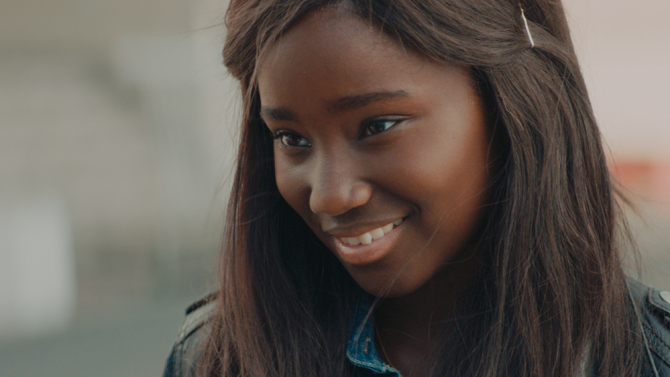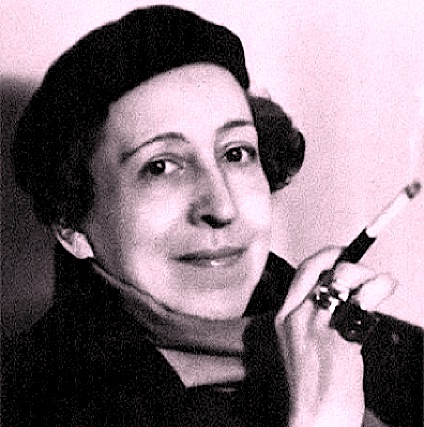This repost by staff writer Ren Jender appears as part of our theme week on Violent Women.
When Boyhood was making its victory lap through critics’ circles and award ceremonies, I wasn’t the only person who thought, “I want a film called Girlhood.” We all got our wish near the beginning of this year when the out writer-director of Water Lilies and Tomboy, Céline Sciamma, gave us the art house US release Girlhood about a French, Black teenager, Marieme (Karidja Touré). The English title isn’t an exact translation of the original French Bande de Filles (“Group of Girls”) which was in production long before Boyhood was released–and perhaps even before that film was called Boyhood: the original title was 12 Years. Still, I was eager to see Sciamma’s film–until I read about its “bleak” ending and some talk from women of color that they found the writer-director’s take on Marieme’s life lacking. When the film played at my local art house as a revival months after its first run, I went to see it. I’m glad I did, but now I understand both reactions: the effusive praise and the cringing.
Girlhood starts on a peak note: a slow-motion scene of what looks like Black men playing American tackle football on a field at night, wearing helmets, shoulder pads and mouth guards, so we don’t realize–until we notice the players’ breasts under their uniforms–that they are all girls. Marieme and the rest of the team all live in the same neighborhood so after the game they walk home together with each saying “Good night” to the rest as she leaves the group to go home. Marieme is the only one left at the end, making her way up to her family’s apartment, where we see that she and her sister, who is a couple of years younger than she is, (Marieme is 15 or 16 at the beginning of the film) are the ones raising their much younger sister, cooking her meals and doing the dishes while their mother works. Their older brother is a physically abusive, petty dictator who kicks Marieme out of the living room when he comes home, so he can have the computer soccer game she was playing to himself.
Marieme finds out that she is flunking out of school and an unsympathetic counselor won’t listen to her excuses, or allow her to redeem herself. Dejected, she leaves, then just outside the school meets up with a group of three girls about her age, also not attending classes, who invite her to go to Paris with them (the film seems to mostly take place in the Parisian suburbs). At first she turns them down but when she notices the attention they receive from a group of local boys (including a friend of her brother’s she’s attracted to) she decides to go to Paris with the other girls after all.

In the city the girls unapologetically take up space, whether blasting music and teaching each other dance routines in a crowded metro car (with the white passengers turning their backs on them, pretending not to notice) or shaming and shoving a white clothing store clerk who profiles them. Marieme is entranced and becomes a permanent part of the group. She exchanges her long braids for the long straight weave/wig similar to that of the leader of the group Lady (Assa Sylla) and intimidates one of her former football teammates into giving her money that the group pool into a night in a motel room (with extra for food and booze). While she’s partying with her friends her brother calls, but Lady, while taking a bath, instructs her not to answer. She tells Marieme, “You do what you want.” When Marieme repeats the words back to Lady, she says she should look in her bag for a gift, a necklace that spells out “Vic.” “As in ‘victory,'” Lady tells her. We later find out “Lady” isn’t her real name either: it’s “Sophie.”
In another highlight the girls lip sync to “Diamonds” (the Sia Furler song sung by Rihanna) while in the room, wearing the new dresses they’ve shoplifted, dancing (shot stunningly by cinematographer Crystel Fournier) like they are in their own music video. But the high life never lasts–afterward when Marieme, now known as “Vic” returns to the apartment her brother chokes her, telling her to never ignore his calls again.
By this time Vic’s nearly silent mother knows that she is out of school and has arranged for her to join her at her job cleaning hotel rooms. We see the defeated expression on Vic’s face as she scrubs a bathroom sink but aren’t prepared when, at the end of the shift, Vic grabs the supervisor’s hand, as in a handshake but squeezes and twists it until the supervisor agrees to tell her mother that she doesn’t have a position for Vic after all.
We’re used to seeing teenaged protagonists, especially those who suffer physical abuse at home, turn to petty crime and violence in film, but they’re rarely girls: the only other unapologetically violent, girl-protagonist that comes readily to mind is Reese Witherspoon’s Vanessa in 1996’s Freeway. We see Lady and the others in the group call out insults to other groups of Black girls which sometimes leads to nothing and sometimes culminates in scheduled fights (complete with a crowd of spectators filming the event with their phones). One of these fights leads to a humiliating defeat for Lady and the chance for Vic to avenge it. In Vic’s fight, she not only takes off the other girl’s shirt, as the girl did to Lady, she takes out her switchblade and cuts off the girl’s bra as well. When she comes home, her brother, who apparently saw the fight on YouTube, instead of hitting her (as he usually does when he calls her into a room) invites her to play computer soccer with him.
When Vic sees her younger sister with a group of other girls her age robbing a woman’s purse she ‘s upset. On the train ride home she implies she too will swear off stealing and fighting–only to find her brother waiting for her in the apartment with a beat-down, angry that she’s had sex with his friend (this boyfriend is one of the only Black men or boys in the film who is presented as more than a cardboard thug).
Sciamma is at her best when the girls are alone together (including an early funny scene between Marieme and her slightly younger sister) and also as in her earlier films when her characters seem to be exploring their sexual orientation and gender expression. Unlike every other woman or girl character in a movie, when Vic is in a dress and high heels it’s only until she can change into sweats and sneakers. At one point she wears her hair in short cornrows and binds her breasts, to protect herself as a woman alone on the street, but she continues to wear her “disguise” when she is at home as well. The scenes when she talks to Lady in the bathtub as well as a later dance with a sex worker/roommate have a sexual tension to them that Vic’s scenes with her boyfriend (even as she, just before they have sex together for the first time, objectifies his bare ass) don’t equal.
But during other scenes I felt Sciamma was observing these girls as a sociologist or tourist might, as opposed to truly seeing and understanding them or giving their scenes the same nuance the white male director of Our Song gave to the girls of color who were his main characters. The sometimes careless cinematography doesn’t help; although Touré is photographed beautifully in most of the first part of the film (she’s never lovelier than when, in the presence of the boy she likes, she looks down and smiles) in some latter parts she’s poorly lit (a persistent problem of white photographers and cinematographers with dark skinned actresses/subjects), so we can’t clearly make out her features.
Other reviews made me dread a downer ending. Needlessly degrading or deeming “hopeless” a woman or girl character is one of the biggest clichés writers, especially male ones, have at their disposal and I’m not the only woman who is sick of it. But the last shot of Vic isn’t any more hopeless than the one of another, very famous teenaged protagonist in French film who had also gotten into a lot of trouble, Antoine Doinel in François Truffaut’s The 400 Blows. And unlike him, Vic wears a look of determination on her face as she walks purposefully away from us.
[youtube_sc url=”https://www.youtube.com/watch?v=AabCFCREVbQ” iv_load_policy=”3″]
Ren Jender is a queer writer-performer/producer putting a film together. Her writing besides appearing every week on Bitch Flicks has appeared in The Toast, xoJane and the Feminist Wire. You can follow her on Twitter @renjender.




